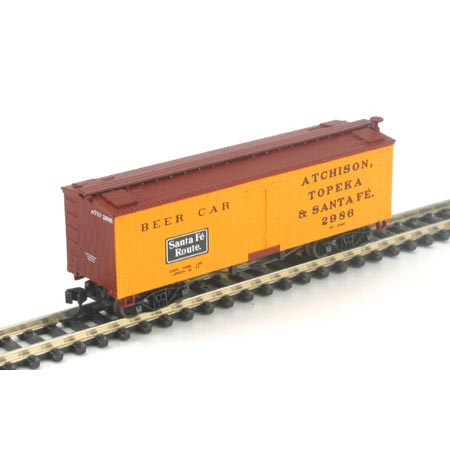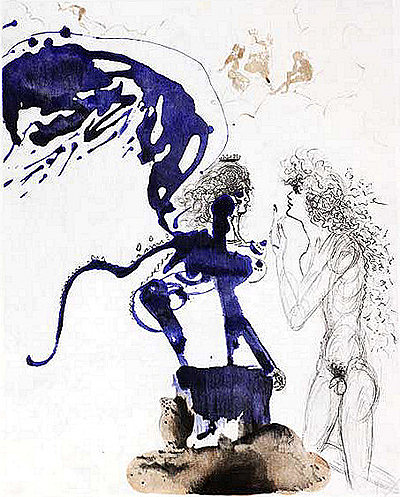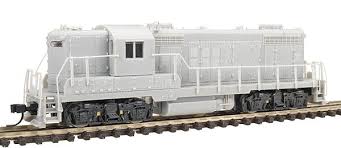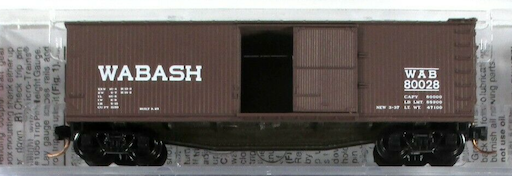Model Information: Introduced by Trainworx in 2016, these models feature: Die cast metal under frame for superior tracking;
Scale trucks with Fox Valley metal wheels;
Body mounted magnetic knuckle couplers;
Etched metal grab bars and stirrups.
In 1958, the New York Central introduced the new Flexi-Van Container-on-Flatcar (COFC). It was designed to help reclaim business that had been lost to trucks. With its specialized hardware, it provided a true intermodal transport system that used railroad transport for the long haul and highway transport for local pickup and delivery. Key to Flexi-Van were specially designed railroad flatcars with built-in compact turntables used in transferring containers from truck chassis without the need for circus ramps, overhead cranes, or forklifts. By virtue of its clever technology, Flexi-Van was intended to overcome many of the perceived disadvantages of COFC transport while making the most of the high quality service possible through intermodal transportation.
In 1958, the New York Central introduced the new Flexi-Van Container-on-Flatcar (COFC). It was designed to help reclaim business that had been lost to trucks. With its specialized hardware, it provided a true intermodal transport system that used railroad transport for the long haul and highway transport for local pickup and delivery. Key to Flexi-Van were specially designed railroad flatcars with built-in compact turntables used in transferring containers from truck chassis without the need for circus ramps, overhead cranes, or forklifts. By virtue of its clever technology, Flexi-Van was intended to overcome many of the perceived disadvantages of COFC transport while making the most of the high quality service possible through intermodal transportation.
Prototype History: A flatcar (US) (also flat car (US) or flat wagon (UIC)) is a piece of railroad (US) or railway (non-US) rolling stock that consists of an open, flat deck mounted on a pair of trucks (US) or bogies (UK), one at each end containing four or six wheels. Occasionally, flat cars designed to carry extra heavy or extra large loads are mounted on a pair (or rarely, more) of bogeys under each end . The deck of the car can be wood or steel, and the sides of the deck can include pockets for stakes or tie-down points to secure loads. Flatcars designed for carrying machinery have sliding chain assemblies recessed in the deck.
Flatcars are used for loads that are too large or cumbersome to load in enclosed cars such as boxcars. They are also often used to transport intermodal containers (shipping containers) or trailers as part of intermodal freight transport shipping.
COFC (Container On Flat Car) cars are typically 89' long and carry four 20' intermodal containers or two 40'/45' shipping containers (the two 45' containers are carryable due to the fact that the car is actually 92' long, over the strike plates). With the rise of intermodal freight transport-specific well cars that allow double stacking, and given the age of most of these flats, numbers will decline over the next several years
From Wikipedia
Flatcars are used for loads that are too large or cumbersome to load in enclosed cars such as boxcars. They are also often used to transport intermodal containers (shipping containers) or trailers as part of intermodal freight transport shipping.
COFC (Container On Flat Car) cars are typically 89' long and carry four 20' intermodal containers or two 40'/45' shipping containers (the two 45' containers are carryable due to the fact that the car is actually 92' long, over the strike plates). With the rise of intermodal freight transport-specific well cars that allow double stacking, and given the age of most of these flats, numbers will decline over the next several years
From Wikipedia
Road Name History: 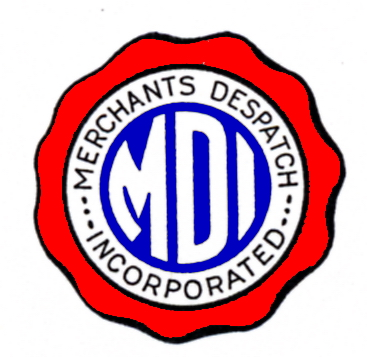 Merchants Despatch Transportation called East Rochester, NY home and most of its railroad cars were built there starting in 1898. Here are several illustrations scanned from a 1928 MDT 12-month calendar showing some of the different cars and specifically refrigerator cars that were built by MDT for different purposes.
Merchants Despatch Transportation called East Rochester, NY home and most of its railroad cars were built there starting in 1898. Here are several illustrations scanned from a 1928 MDT 12-month calendar showing some of the different cars and specifically refrigerator cars that were built by MDT for different purposes.
The Merchants Despatch Transportation Company (MDT, also known as the Merchants Despatch Refrigerator Line) was established in 1857 or 1858 by the American Express Company of New York (then a freight forwarding service). The entity was reformed as a joint stock trading company on June 1, 1869, with ownership divided among the Cleveland, Columbus, Cincinnati and Indianapolis Railway (CCC&I), the Lake Shore and Michigan Southern Railway, and the New York Central Railroad (NYC), all part of the Cornelius Vanderbilt rail empire.
From Wikipedia

The Merchants Despatch Transportation Company (MDT, also known as the Merchants Despatch Refrigerator Line) was established in 1857 or 1858 by the American Express Company of New York (then a freight forwarding service). The entity was reformed as a joint stock trading company on June 1, 1869, with ownership divided among the Cleveland, Columbus, Cincinnati and Indianapolis Railway (CCC&I), the Lake Shore and Michigan Southern Railway, and the New York Central Railroad (NYC), all part of the Cornelius Vanderbilt rail empire.
From Wikipedia
Brand/Importer Information:  Trainworx was founded in 1999 by Pat Sanders and is located in Delta Colorado. Their first freight car was the Quad hopper and it was released in 2000. They have been making N scale products ever since. Their website can be found at www.train-worx.com. As of 2016, they have produced 8 different rolling stock body styles as well as a range of different highway vehicles in N Scale. Their limited edition runs have proven a huge success with collectors and modelers enjoy the accuracy of all their products.
Trainworx was founded in 1999 by Pat Sanders and is located in Delta Colorado. Their first freight car was the Quad hopper and it was released in 2000. They have been making N scale products ever since. Their website can be found at www.train-worx.com. As of 2016, they have produced 8 different rolling stock body styles as well as a range of different highway vehicles in N Scale. Their limited edition runs have proven a huge success with collectors and modelers enjoy the accuracy of all their products.
Trainworx sells their products both through tradional retail channels as well as directly by phone order. When asked "What prompted you to found Trainworx?", Pat Sanders responded "There was a freight car that hadn't been done in N scale that I just had to have and it didn't look like anyone was ever going to make it."

Trainworx sells their products both through tradional retail channels as well as directly by phone order. When asked "What prompted you to found Trainworx?", Pat Sanders responded "There was a freight car that hadn't been done in N scale that I just had to have and it didn't look like anyone was ever going to make it."
Item created by: gdm on 2016-07-26 15:02:33. Last edited by gdm on 2022-03-14 10:04:37
If you see errors or missing data in this entry, please feel free to log in and edit it. Anyone with a Gmail account can log in instantly.
If you see errors or missing data in this entry, please feel free to log in and edit it. Anyone with a Gmail account can log in instantly.




